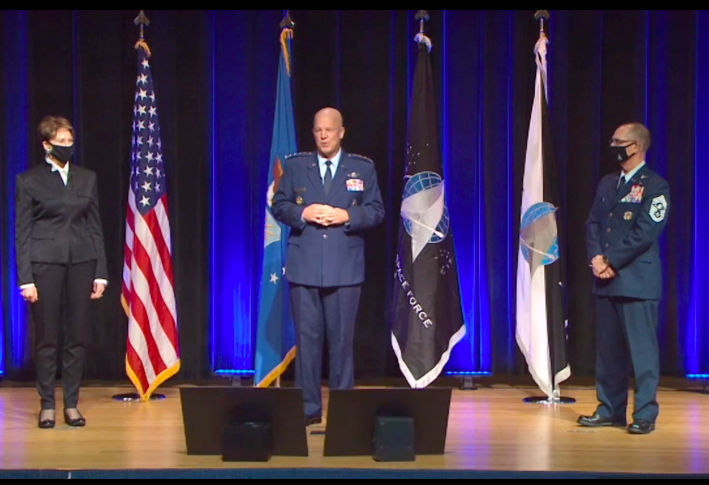
Air Force Secretary Barbara Barrett (left), Gen. Jay Raymond (middle)
WASHINGTON: The Space Force will expand use of commercial satellites over the next several years, including for new mission types such as on-orbit satellite repair and refueling, Chief of Space Operations Gen. Jay Raymond says.
“What used to be commercially viable now is just a subset of what can be commercially viable, and there’s a huge opportunity going forward,” he told the US Chamber of Commerce’s LAUNCH event on the future space economy yesterday.
“Today we leverage commercial launch, we leverage commercial SATCOM, in a significant way for joint coalition forces,” Raymond explained. “We also are now beginning to leverage commercial … space domain awareness. And I will tell you, there’s other missions that that will materialize here in the future: commercial weather, commercial on-orbit servicing. So, we see a huge opportunity here to have a fused relationship with industry that will provide great advantage.”
In addition, Raymond said, the Space Force is learning from industry how to adapt business practices to speed development and production of new systems, where commercial industry is able to move faster than traditional defense programs. “We’re eager to partner on that front as well,” he said.
Air Force Secretary Barbara Barrett, who appeared beside Raymond, stressed that the entire service is looking at a number of ways to speed its acquisition process.
“Internally, we’re changing some of the acquisition processes, and we’re also working [on] requesting congressional authority to speed up our acquisitions processes,” she said. “Of course, we have to continue to do it in accordance with the law. We work to ensure that we continue with transparency, accountability. But still, we are working to break land speed records to get things in in the field faster.”
Barrett said that part of this effort is the service’s rapid embrace of digital engineering across the board for new weapon systems. “Digital engineering isn’t an option … it’s essential. It’s faster, it’s cheaper, it’s better,” she said.
It is particularly important for space systems, she explained, as satellites are produced in small numbers and are essentially irretrievable for physical modernization after they are launched. “It’s much more important for us to test and and analyze the capabilities before we launch them. And there are continuous upgrades that are possible because of digital engineering,” she said.
While the military is moving to embrace the commercial world’s advent of constellations of large number of smaller satellites, Barrett added, the need for digital engineering doesn’t go away — instead it becomes even more central. This is because constellations and their more numerous ground stations have to be linked in a complex, dynamically function web.
“All of that has to be resilient and has to be speedy. Creating those systems, if we didn’t have digital engineering, it simply wouldn’t be possible — or it would be vastly more expensive to get done,” she said.
Asked about efforts to bolster interoperability with allies, Barrett stressed that efforts are underway with regard to both air and space operations and new capabilities.
“I just returned from visiting with our Singaporean friends and with the Indonesian Minister of Defense. And also the Philippines; and for that matter also the Japanese and Korean air chiefs,” she said. “They are very interested in working with the United States. Similarly, our NATO friends are very excited about our partnerships, and they are very much boosting their support for defense. It’s a new day dawning.”
As I reported earlier this month, Space Command is seeking to broaden and deepen allied integration into day-to-day space operations. Further, Space Force is seeking ways to work with non-traditional actors such as Brazil — and is even looking to expand joint acquisition activities with countries such as Luxembourg and the Netherlands.
“The SMC Chief Partnership Office seeks innovative opportunities to leverage traditional and non-traditional partners to supplement and enhance the U.S. space architecture,” Steven Pluntze, deputy chief of SMC’s Partnership Office, told me in an email yesterday.
“Luxembourg is a valuable NATO partner and is home to a dynamic space industry. We are currently exploring a number of possibilities with the Luxembourg Ministry of Defence to continue to deepen our partnership in space, including how the US DoD could leverage the mPOWER MEO SATCOM constellation via international agreements,” he said. That constellation, based in Medium-Earth Orbit (MEO) is SES’s planned next-generation O3b communications satellites.
Further, Pluntze said, SMC also has “partnered with the Netherlands Ministry of Defence, Norwegian Ministry of Defence, and the Norwegian Space Agency on a virtual space accelerator program that focused on next-generation space technologies. We hope to take lessons learned to facilitate more events like this in the future.”
“One of the things I’m most proud of is over the last three or four years or so we have seen a significant uptick in our partnership activities,” Raymond told the virtual LAUNCH audience. “We’re operating together, we’re wargaming together, and now we’re building capability together. We think this provides advantage to our partners and to us.”
Air Force awards SNC $13B contract for new ‘Doomsday’ plane
The win is a major victory for the firm in a competition that saw the surprise elimination of aerospace giant Boeing.


























